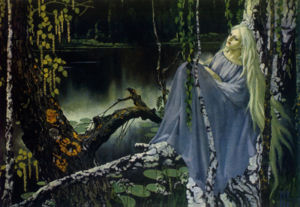On November 27th, 2022, the 8,000th article was added to the SuccuWiki!
Rusalka
For other uses of the word Succubus, see Succubus (disambiguation).
This article is taken from the original Wikipedia entry here.
In Slavic mythology, a rusalka (plural:rusalki) was a female ghost, water nymph, succubus or mermaid-like demon that dwelled in a waterway.
According to most traditions, the rusalki were fish-women, who lived at the bottom of rivers. In the middle of the night, they would walk out to the bank and dance in meadows. If they saw handsome men, they would fascinate them with songs and dancing, mesmerise them, then lead the person away to the river floor, to live with them. The stories about rusalki have parallels with the Germanic Nix the Irish Banshee, Scottish Bean Nighe and Slavic fairies.
Origin
In most versions, the rusalka is an unquiet dead being, associated with the "unclean force". According to Zelenin, people who die violently and before their time, such as young women who commit suicide because they have been jilted by their lovers, or unmarried women who are pregnant out of wedlock, must live out their designated time on earth as a spirit.
The ghostly version is the soul of a young woman who had died in or near a river or a lake and came to haunt that waterway. This undead rusalka is not invariably malevolent, and will be allowed to die in peace if her death is avenged.
Rusalki can also come from unbaptised children, often those who were born out of wedlock and drowned by their mothers for that reason. Baby rusalki supposedly wander the forest begging to be baptised so that they can have peace. They are not necessarily innocent, however, and can attack a human foolish enough to approach them.
Description
While her primary dwelling place was the body of water in which she died, the rusalka could come out of the water at night, climb a tree, and sit there singing songs, sit on a dock and comb her hair, or join other rusalki in circle dances (хороводы, korowody) in the field.
Though in some versions of the myth, the eyes shine like green fire, others describe them as extremely pale, with no visible pupils. Her hair is sometimes depicted as green, and often perpetually wet. According to some legends, should the rusalka's hair dry out, she will die.
Rusalki like to seduce men. They can do so by enticing men with their singing and then drowning them. Men seduced by the rusalka could die in her arms, and in some versions hearing her laugh could also cause death.
Specifics pertaining to rusalka differed within regions. Although in most tales they lived without men, in Ukraine they were often linked with water, while in Belarus they were linked with the forest and field. Where land was fertile, the maidens appeared naked and beautiful. In harsher areas of Great Russia, they appeared as "large breasted amazons" (Hubbs). And often, in the north, they were ugly and covered in hair.
Rusalka Week
The rusalki were believed to be at their most dangerous during the Rusalka Week (Rusal'naia) in early June. At this time, they were supposed to have left their watery depths in order to swing on branches of birch and willow trees by nights. Swimming during this week was strictly forbidden, lest mermaids would drag a swimmer down to the river floor. A common feature of the celebration of Rusal'naia week was the ritual banishing or burial of the rusalka at the end of the week, which remained as entertainment in Russia until the 1930s [1].
Max Vasmer notes that the very word rusalka originally referred to the dances of girls at Whitsuntide. The word is derived through Greek ῥουσάλια from "rosalia", the Latin term for Whitsuntide week (originally it meant "the festival of roses").
Music and literature
Music
- Alexander Dargomyzhsky's opera Rusalka
- Rimsky-Korsakov's opera May Night
- Antonín Dvořák's opera Rusalka
- Leprechaun's album The Ultimate Dance, track 4.
- Finnish rockband CMX uses Rusalki as a name for a group of cruel hunter/killer cyborgs on their album Talvikuningas.
Literature
- Folk tales about rusalki gave rise to Pushkin's unfinished dramatic poem, praised by Vladimir Nabokov as one of his most ingenious works, and Gogol's short story May Night or the Drowned Maiden.
- Also a name of a fantasy novel by C. J. Cherryh.
- A rusalka is also used as a plot device in Tigana, a novel by Guy Gavriel Kay.
- Rusalki are featured in "Fortunate Fool", an entertaining fantasy by Mercedes Lackey.
Games
- There are five Rusalki (a "cycle") present in the Magic: the Gathering card game set Guildpact.
- The Rusalka is a character in the epic adventure game series Quest for Glory. She appears in the fourth installment, Shadows of Darkness, and the Paladin character may avenge her death and set her spirit free as part of a quest.
- Rusalki are present in the DOS-based RPG Betrayal at Krondor.They often are found near rivers.
- Rusalka are used as the bait antanae of the Demons Dagon and Bael in Devil May Cry 4. One is gained by Nero and absorbed into his Devil bringer arm for a special ability after Nero fights Bael.
Notes
- ↑ Linda Ivanits, Russian Folk Belief, p 80
References
- Д.К. Зеленин. Очерки русской мифологии: Умершие неестественною смертью и русалки. Москва: Индрик. 1995.
